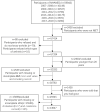Association between asymptomatic hyperuricemia and risk of arthritis, findings from a US National Survey 2007-2018
- PMID: 38346893
- PMCID: PMC10862310
- DOI: 10.1136/bmjopen-2023-074391
Association between asymptomatic hyperuricemia and risk of arthritis, findings from a US National Survey 2007-2018
Abstract
Background: Arthritis is thought to be closely related to serum uric acid. The study aims to assess the association between asymptomatic hyperuricemia (AH) and arthritis.
Methods: A multistage, stratified cluster was used to conduct a cross-sectional study of adult US civilians aged≥20 years from the 2007-2018 National Health and Nutrition Examination Survey. Participants with hyperuricemia and without hyperuricemia prior to gout were included. A questionnaire was used to determine whether participants had arthritis and the type of arthritis. Logistic regression was used to investigate the association between hyperuricemia and arthritis.
Result: During the past 12 years, the percentage of participants with arthritis changed from 25.95% (22.53%-29.36%) to 25.53% (21.62%-29.44%). The prevalence of osteoarthritis (OA) increased from 8.70% (95% CI: 6.56% to 10.85%) to 12.44% (95% CI: 9.32% to 15.55%), the prevalence of AH changed from 16.35% (95% CI: 14.01% to 18.40%) to 16.39% (95% CI: 13.47% to 19.30%). Participants with AH were associated with onset of arthritis (OR=1.34, 95% CI: 1.07 to 1.69), but the association was muted after adjusting demographic and socioeconomic factors. For participants aged 40-49 years, AH is associated with incident arthritis (OR=1.96, 95% CI: 1.23 to 2.99) and the relationship remained after adjusting for education level, income to poverty ratio, body mass index, diabetes, hypertension and smoking (OR=2.00, 95% CI: 1.94 to 3.36). Compared with male, female participants with AH are more likely to develop arthritis, especially in OA (OR=1.35, 95% CI: 1.14 to 1.60).
Conclusion: Our data identified AH as the risk factor for incident arthritis, especially for OA, which might be exaggerated in aged population and female population.
Keywords: Knee; Rheumatology; Risk management.
© Author(s) (or their employer(s)) 2024. Re-use permitted under CC BY-NC. No commercial re-use. See rights and permissions. Published by BMJ.
Conflict of interest statement
Competing interests: None declared.
Figures
References
Publication types
MeSH terms
Substances
LinkOut - more resources
Full Text Sources
Medical
Miscellaneous

